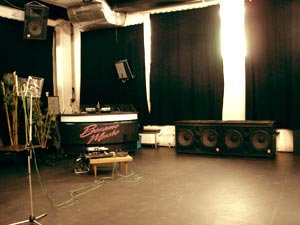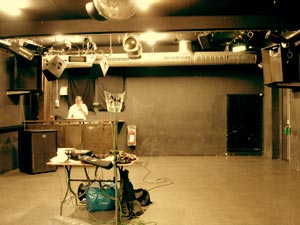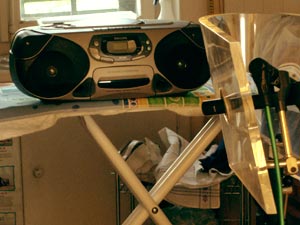| Club Simulation |
It happened to me more than once that a mix which sounded right in the studio didn't work when played for
the first time in a club. Especially at the second club mentioned below the bassline was often hardly recognizable
and the vocals seemed buried in the mix and badly equalized.
One day it occurred to me to me that it would be great to record an impulse response of that club in order to simulate
the impact of the sound system together with the room acoustics using a convolution reverb plugin.
So I lent a pair of microphones from a friend and headed to town..
The emulation using these self recorded impulse responses is far from perfect, but I think they are still a big help
when mixing new songs: You can quickly get an idea what your mix will sound like in a club without leaving the studio.
Below you can listen to a song by King Noah in it's original form and as it sounds in two different clubs and on
a boombox. For the first club I also added the result of emulating the club sound by using the impulse responses.
As you can hear, the high frequencies (high hats) loose some definition in the emulation. Also the stereo image
is far less realistic than in the direct microphone recording. This is probably caused by the
limitations of this method described at the end of the page.
For any feedback or thoughts about this page please use
this dedicated discussion forum thread.
|
| Download |
clubsimulation.zip (2.7 MB)
- impulse responses for two clubs and one boombox in mono to stereo (m2s) and stereo to stereo (s2s) configurations
- preset files for Voxengo Pristine Space
- documentation
|
| How to use the files |
- get a free or paid convolution reverb plug-in like SIR,
Voxengo Pristine Space,..
- start the plug-in in your audio application
- load the desired impulse responses
- mono to stereo files: will work with any Convolution Reverb
- stereo to stereo files: will not work with SIR. A multi channel plugin is needed like
Pristine Space. This is a paid plugin but the free evaluation version can also be used as it is
fully functional except for inserting a moment of silence now and then.
- If using Pristine space just load one of the preset files. This way you won't have to setup the channels
inside the plugin yourself.
- run your final mix through the plugin. set the wet/dry control of the plugin fully to "wet".
|
| Club 1: Besame Mucho, Zurich/Switzerland |

- roughly square shaped room for up to ca. 250 clubbers.
- JBL Speakers (bass + mid/tweeters)
- walls are covered on three sides with curtains which reduce reflections
- some resonating frequencies in the upper bass range
- original song (mp3 192K, 25s)
song as heard in club 1 (mp3 192K, 25s)
true stereo simulation (mp3 192K, 25s)
|

|
|
|
| Club 2: Provitreff, Zurich/Switzerland |
- rectangular room, ca. 200 people max.
- Speakers: D.A.S. (bass), JBL (mid/tweaters)
- bare walls on 4 sides produce lots of reflections
- song as heard in club 2 (mp3 192K, 25s)
|
 |
|
|
| Boombox in Kitchen |
- Many people listen to music mainly on such devices without subbass. So it's a plus if your bassline has some higher frequencies above 200Hz too..
- song as heard in kitchen (mp3 192K, 25s)
|
 |
|
|
| How the Impulse Responses were recorded |
Basic Principle
- A sine sweep from 20Hz to 20KHz is played from a speaker in a room.
- The resulting sound is recorded in stereo using a pair of microphones located at the listener's position.
Alternatively a single microphone or multiple microphones for surround sound can be used.
- The actual impulse response is obtained by processing the recorded sweep with a special deconvolution software.
It would also be possible to record the impulse response directly by sending an impulse (= loud click) through the
speaker, but this method is not suitable in many cases because environmental noise is also recorded (car noise from outside..).
The sweep method automatically averages out most noise. The finished impulse response is a audio file that
sounds as if someone clapped or fired a starter gun inside the room.
Impulse Responses for a Sound System
 If there is more than one sound source in the room a separate impulse response should be created for each source.
In the standard case of a stereo to stereo reverb this means that one stereo impulse response is recorded for the
left speaker and a second one for the right speaker as shown in the figure to the right
If there is more than one sound source in the room a separate impulse response should be created for each source.
In the standard case of a stereo to stereo reverb this means that one stereo impulse response is recorded for the
left speaker and a second one for the right speaker as shown in the figure to the right
 A typical compact club sound system however
has 4 mid/high speakers and at least one bass speaker as can be seen to the right.
A typical compact club sound system however
has 4 mid/high speakers and at least one bass speaker as can be seen to the right.
Since the speakers are either connected
to the right or the left channel of the DJ desk I assume it is sufficient to record one impulse response per channel.
Each channel feeds to more than one speaker, so all speakers on one channel play the same signal and I think
they can be treated as one single sound source.
- The exact procedure for recording the sweeps was:
- play sweep over the left channel of the PA
- record output of stereo mics on DAT
- play sweep over the right channel of the PA
- leave stereo mics in same location and record again on DAT
Additionally I recorded a single mono to stereo response for each club by simply playing the sweep over
the left and right PA channels at the same time.
Limitation of Convolution Method: Linearity
The principle of convolution is based on the assumption that all components involved behave in a linear fashion.
This means that any compression and distortion a PA system may introduce to the sound cannot be expected to
be reproduced. Also windows which start rattling against their frames at bass frequencies will not be emulated.
Limitation of Equipment: Synchronization
The impulse responses were recorded with a DAT recorder. This works fine for the mono to stereo impulses. In the case
of stereo to stereo impulses one ends up with two independently recorded sweep files. The resulting impulse responses
then have to be aligned manually by cutting the leading silence in a wave editor. This method is not very exact as
it is impossible to know the initial delay on each side. I noticed that a small offset between the sides can cause
big difference in the obtained room image. A better solution would be to use a multi-track recorder
(hardware or as software on a laptop pc) where the original sweep can be put on the first track and the recorded sweeps
on tracks 2/3 and 4/5. This way the different recordings are phase-locked automatically.
Empty Room vs. Full Room
These recordings were done in empty clubs. Of course a club packed with people sounds better than an empty
one as there are not as much reflections. Apart from the fact that it would be fairly difficult to motivate a
full crowd to keep completely quiet while playing a 40 second sweep to them it must be clear that sometimes your
music may be played in clubs with few people only. The typical problems with bass frequencies will not be
cured by the crowd anyway. Also I found out that most of my favourite songs do stand the
test fairly well. They may not sound great but at least all main elements of the music are
"acoustically understandable".
Equipment Used
- 2 microphones AKG C 460 B with omnidirectional capsule ck-62
- stereo microphone stand
- M-Audio DMP3 mic preamp
- DAT recorder
- software: Voxengo Deconvolver & Pristine Space
- sweep: 40 second sweep as provided by Voxengo Deconvolver. (Note: When burning the sweep on CD it makes sense to
insert some seconds of silence before and after the sweep as some DJ CD-players generate a loud
click at the beginning and end of the sweep when there is no silence.)
|
| Thanks |
|
|





 If there is more than one sound source in the room a separate impulse response should be created for each source.
In the standard case of a stereo to stereo reverb this means that one stereo impulse response is recorded for the
left speaker and a second one for the right speaker as shown in the figure to the right
If there is more than one sound source in the room a separate impulse response should be created for each source.
In the standard case of a stereo to stereo reverb this means that one stereo impulse response is recorded for the
left speaker and a second one for the right speaker as shown in the figure to the right A typical compact club sound system however
has 4 mid/high speakers and at least one bass speaker as can be seen to the right.
A typical compact club sound system however
has 4 mid/high speakers and at least one bass speaker as can be seen to the right.